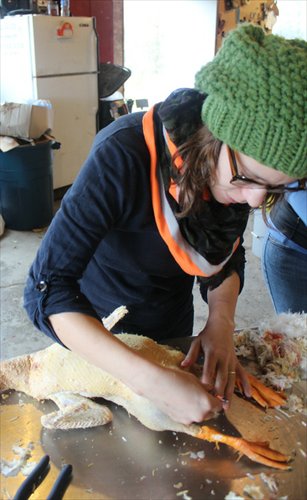US chef promotes Midwest

Amy Thielen cooks. Photo: Courtesy of Amy Thielen
Amy Thielen offers her updated twists on beef pot roast, fried smelt and other classic dishes from her childhood in her first cookbook The New Midwestern Table.
The 39-year-old chef reconnected with her fondness for the cuisine after she and her family moved recently back to Minnesota, US, where she was born. She had spent seven years in New York as a chef at the fine-dining restaurants of Michelin-star chefs David Bouley, Daniel Boulud and Jean-Georges Vongerichten.
Thielen spoke about the uniqueness of Midwestern cooking and grease eggs.
Q: What motivated you to write this book?
A: When I had first moved back home to Minnesota right after college in 1997, I had always thought it would be cool to do a Midwestern cookbook. I had thought it was a bit under-represented and at that time I was obsessed with old cookbooks, church community cookbooks, anything, not just the Midwest but from rural experiences basically across the US.
I was finding a lot of common experiences in the rural experience and old recipes. Then I moved to New York and was completely immersed in the fine-dining scene and I worked in the kitchens of fine dining for seven years. Then coming home, everything came full circle. Then I knew I wanted to write the book, which would have been my take on what Midwestern food might have been, what it is now and what it could be in the future.
Q: Why do you think the Midwest is under-represented in our discussions about regional US cuisines?
A: It's really nobody's fault. It's not that the media hasn't looked at it. I think as a nation we are just starting to look at our regional cuisines. They are just starting to gel. I also think naturally Midwesterners are not the kind of people who seek out the spotlight. We have been reticent about things and that's just who we are.
Q: How does that Midwestern sensibility manifest in the region's cooking?
A: I live in a rural part of the Midwest so that's like rural cooking anywhere. Traditionally Midwesterners rely on their preserving. That's the hallmark of our cooking, the jarring, the canning, the jam-making, all of these things that keep proof of summer in your pantry. In the winter time Midwestern cooks have to rely on their inventiveness. The force of the seasons here forces us to be inventive as cooks.
Q: So what makes Midwestern dishes unique?
A: When I think about Midwestern food, I would often characterize it not necessarily by a certain dish but by a certain informality and hospitality. There are a lot of sweets, dips and appetizers and things like that. It comes down to dips and bars. In my book, I enjoyed modernizing them, making them fit modern tastes. I feel a lot of the chefs around the region are doing the same thing.
Q: Did your fine-dining background come in handy to modernize these Midwestern staples?
A: What I've taken away are a batch of tricks and tips and formulas about how to combine flavors. My mom and grandmother were really excellent cooks. I see a lot of connections between things. In my time in fine dining I realized how the roots of fine-dining cooking came from the peasant traditions of Europe and even America. They could be fancy or really dead simple. My approach is to lighten things up or brighten them up with a bit of more flavors.
Q: What was a favorite dish you grew up on?
A: My mom made grease eggs. She would make bacon and cook the eggs in the bacon fat. She would soufflé the eggs in it. She would shake the pan rhythmically and pour the fat over the eggs. If you do it really quickly it causes the eggs to soufflé or puff up. It's really decadent with delicious edges. The yolks just spill all over the plate.
Q: What are essential pantry items in your kitchen?
A: Fresh lemons, fresh garlic and a small strainer. Those are things I need. You'd be amazed how a little bit of lemon juice perks up whatever that's going on.
Fire-and-Iceberg Salad (serves 6 to 8)
½ clove garlic, finely grated
1 teaspoon tomato paste
1 teaspoon sweet paprika
½ teaspoon smoked paprika
1 tablespoon honey
2 tablespoons red or white wine vinegar
1 tablespoon fresh lemon juice
7 tablespoons extra-virgin olive oil
1/8 teaspoon cayenne pepper, or to taste
Fine sea salt and freshly ground black pepper
½ cup walnut halves or pieces
1 tablespoon salted butter
½ large head iceberg lettuce, outer leaves removed
1 small head radicchio
1 light green celery heart, thinly sliced
100 grams blue cheese, crumbled
For the dressing, combine the garlic, tomato paste, both paprikas, honey, vinegar, and lemon juice in a small bowl, and stir to combine. Whisk in 6 tablespoons of the olive oil. Season with the cayenne, 1/4 teaspoon salt and 1/8 teaspoon pepper. Pour the dressing into a small pitcher for serving at the table. To toast the walnuts, combine them with the last 1 tablespoon olive oil and a tablespoon of butter in a skillet set over medium-low heat. Season with salt and pepper.
Cook, tossing regularly, until the walnuts are fragrant and have turned golden brown, about five minutes. Let the nuts cool.
Tear the iceberg lettuce and the radicchio into bite-size pieces and combine in a large salad bowl. Add the celery and the walnuts (cooking fat and all), and toss to combine. Sprinkle the blue cheese over the top and serve immediately, passing the dressing alongside.
Note: For perfectly crisp salad, drizzle the dressing over own salad. Tossing the iceberg with the dressing before it reaches the table causes the lettuce to wilt.